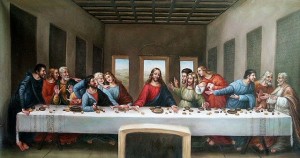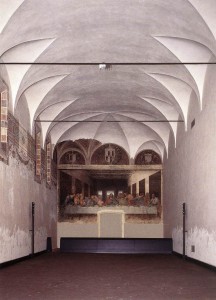The Last Supper is one of the most famous of Leonardo’s pictures. Commissioned by da Vinci’s patron, Ludovico Sforza, Duke of Milan, it was painted on a wall inside the convent of Santa Maria della Grazie in Milan in the 1490s. The Last Supper had always been a popular subject for devotional painting but Leonardo’s interpretation lifted the image to a higher plane in terms of art.
Firstly it was a snapshot fixed on a specific moment during the meal when Jesus shocked his comrades
Verily, verily, I say unto you, he that receiveth whomsoever I send receiveth me; and he that receiveth me receiveth him that sent me.
When Jesus had thus said, he was troubled in the spirit, and testified, and said, Verily, verily, I say unto you, that one of you shall betray me.
The disciples looked one on another, doubting of whom he spake.
Look at the expressions and postures of the disciples – Leonardo portrayed them as ordinary men suddenly charged with conflicting emotions, not (as had traditionally been done) as a gathering of “saints” with either pious or adoring faces.
See how he also forces the onlooker to focus on the picture through the figure of Jesus, calm and serene compared with all the others.
Bartholomew, James Minor and Andrew form a group of three. All are aghast, Andrew to the point of holding his hands up in a “stop!” gesture.
Judas, Peter and John form the next group of three. Judas, you will note, has his face in shadow and is clutching a small bag (of silver?). Peter is visibly angry and a feminine-looking John seems about to swoon.
Christ is the calm in the midst of the storm.
Thomas, James Major and Philip are next. Thomas is clearly agitated, James Major stunned and Philip seems to be seeking clarification.
Matthew, Thaddeus and Simon comprise the last group of three figures. It appears that, when a situation turns ugly, Simon is the “go to” guy for explanations.
The potency of this work of genius is immeasurable – it allows the observer into the painting itself through the strange interaction between the divine serenity of the eternal Jesus and the so recognisable ordinary everyday humanity of the disciples. In this way Leonardo’s achievement is to transform what is essentially a two dimensional wall decoration into a moment when the hand of God Himself appears to reach out to the unexpecting passer by.
For anyone in London between now and early February there is a once in a lifetime chance to see a unique collection of da Vinci’s paintings at the National Gallery. You will not see the original mural, of course – that remains forever upon the wall of the convent. But there will be an early copy.
One point to note…..looking at the mural it appears to suggest the back of a large empty chair opposite Jesus – it is, in fact, a door, built into the wall by some witless oaf a century after the painting had been finished…..


